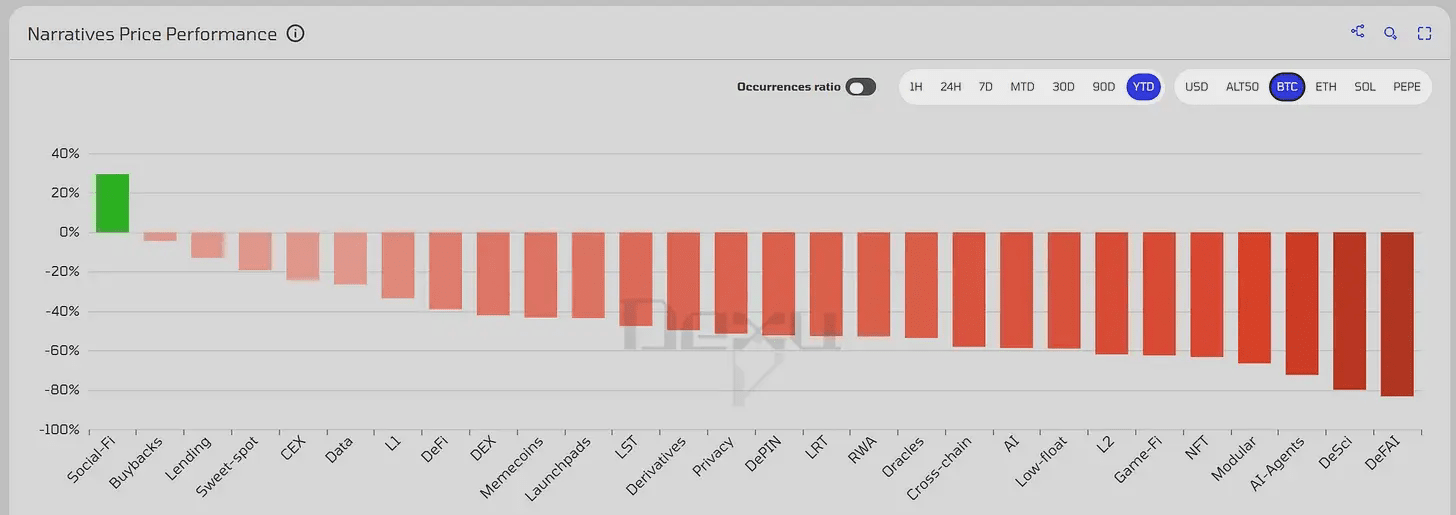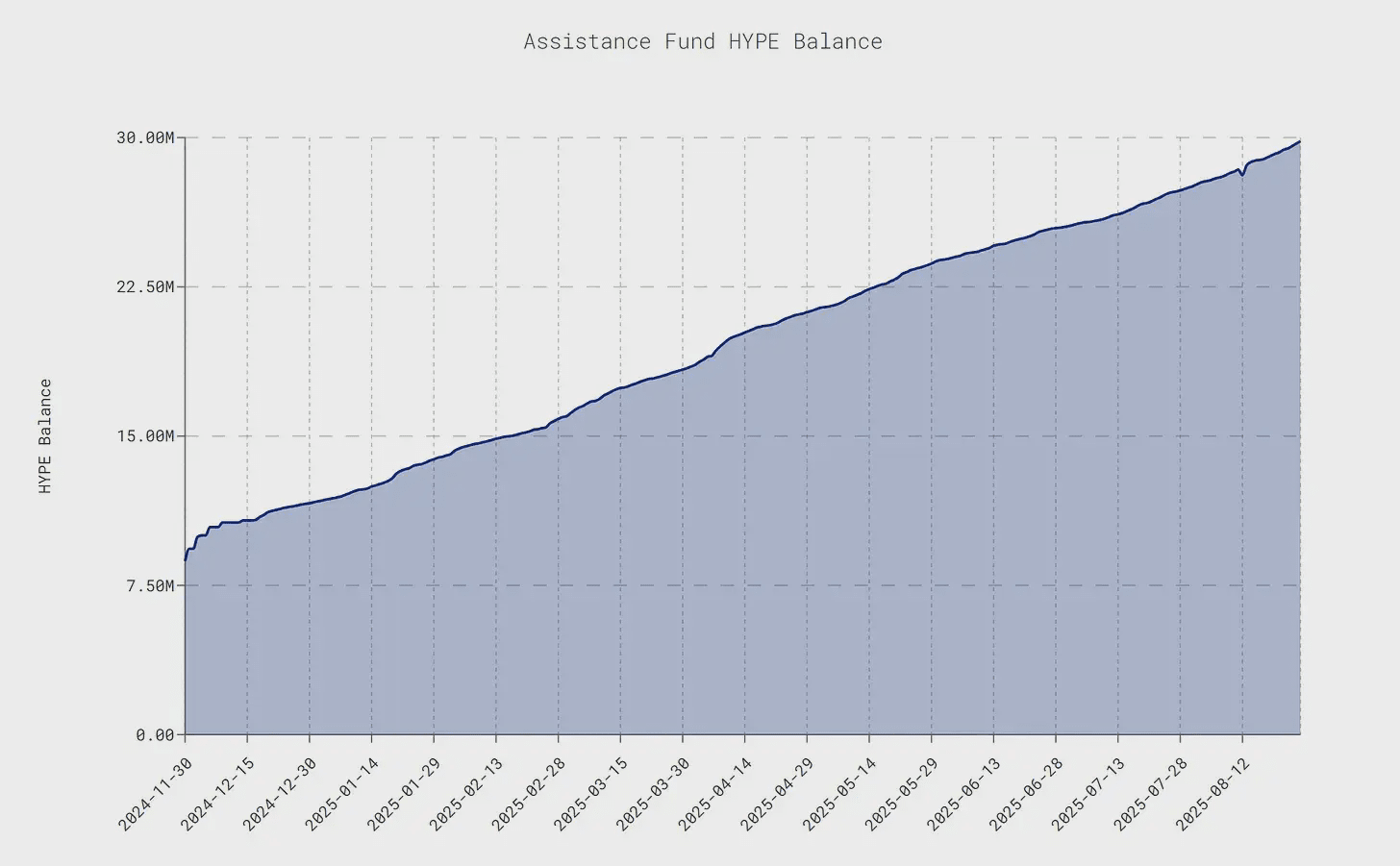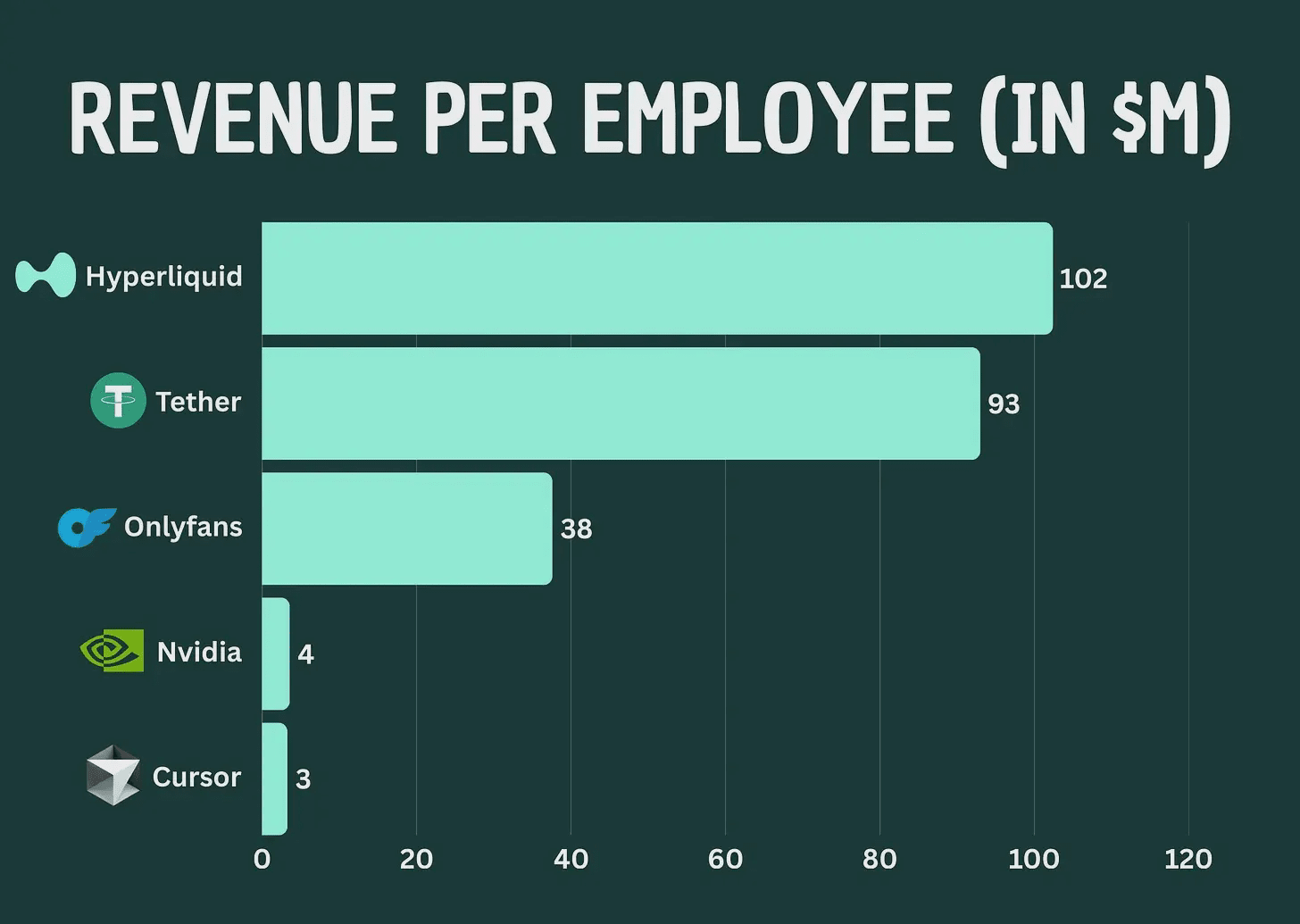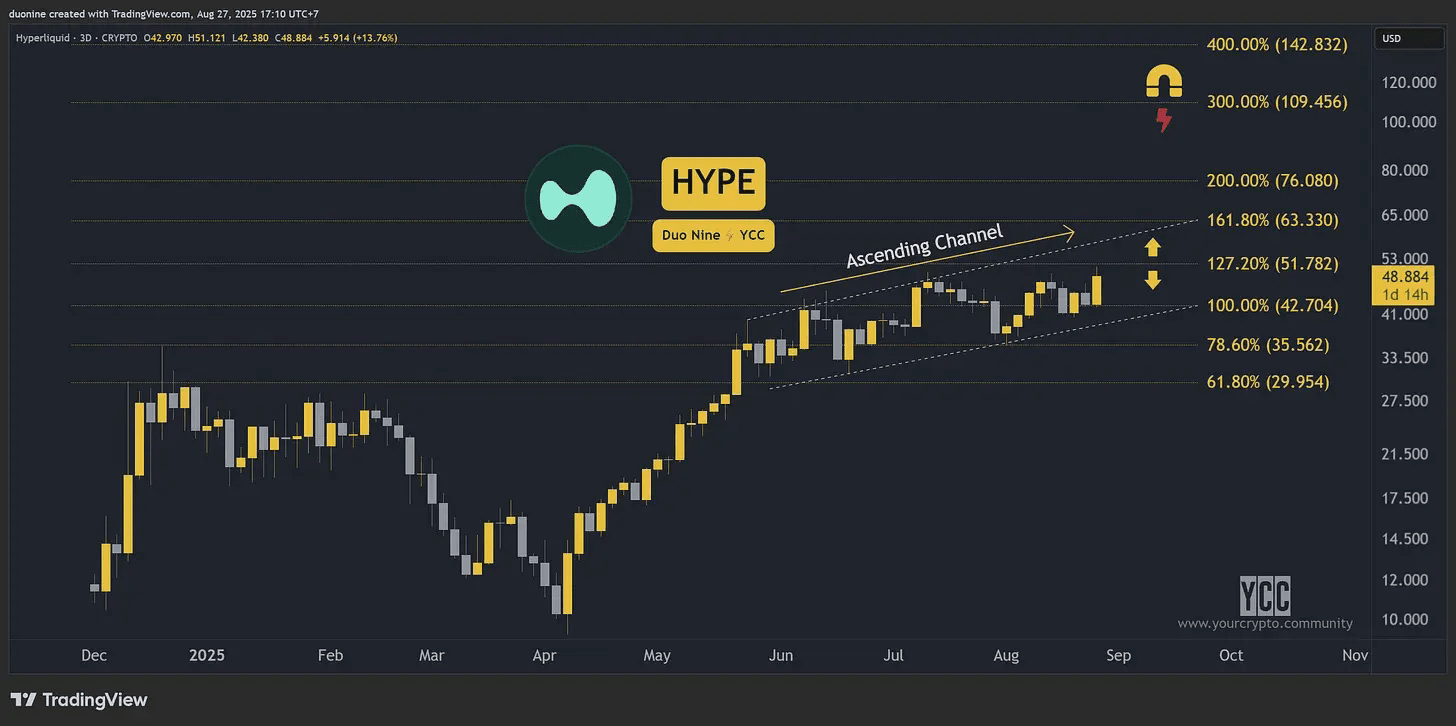Author: Duo Nine
Translation by: Tim, PANews
This year's performance of altcoins has been quite disappointing, with most showing poor trends, but there’s one major exception: HYPE.
What makes Hyperliquid different? What are its development prospects?
I will answer this question later. In the meantime, in the past 24 hours, HYPE has broken its historical high of $50, and it is expected to set new highs this year.
First, let's quickly go through the year-to-date performance of most altcoins relative to Bitcoin. Notice anything in the chart below? All sectors are down except for SocialFi.
In other words, simply holding Bitcoin in 2025 is a wiser choice. The exceptions in the SocialFi projects include tokens like Cookie, Kaito, and Zora, which have recently surged by 15 times, as I reported in the last Alpha Post.

Image from dexu.ai
Once you compare the performance of altcoins with Bitcoin and filter out the outstanding coins, the range of options becomes very limited, with HYPE being one of these few coins, serving as the governance token for Hyperliquid. Let's start our discussion from the very first part.
What sets Hyperliquid apart?
TLDR: Most cryptocurrencies are about how to extract value from users, while Hyperliquid goes against the tide and does something different.
Before we discuss some examples, it's important to define the term 'extractive.' It refers to protocols or chains that extract funds from users but never give back to their ecosystem. These funds ultimately disappear into the project team's bank accounts.
This practice reappears periodically under new brands and narratives, with the operators usually being the same group of people who continuously repeat their tactics to legally extract money from users.
Let’s take a few recent examples to illustrate this:
The Pump.Fun platform has earned billions in fees by issuing Meme coins extensively on the Solana chain. Subsequently, they raised huge sums from investors in a pre-sale before the token launch. However, the PUMP token plummeted by 67% right after its listing. They took a lot from users but gave back very little.
Cronos: Crypto.com created the CRO token in 2018, with an initial issuance of 100 billion tokens. In 2021, to support the coin price, the project destroyed 70 billion tokens. However, in March 2025, after a vote led by insiders, they issued 70 billion tokens again. This operation sacrificed user interests rather than creating value for them.
TRUMP/MELANIA/YZY: These celebrity coins are classic examples of extraction operations. Once a celebrity agrees to collaborate, the token is created privately and allocated to insiders. When the token is listed, those tokens obtained at zero cost are sold for hard currency. Not a dime is returned to the users, all is taken away.
Now let’s take a look at Hyperliquid.
They launched a decentralized exchange, initially kickstarting the project by paying rebate fees to all those providing liquidity to the order book (whom we call market makers). Specifically, market makers earn by placing limit orders, with their profits derived from the fees paid by takers being split between the Hyperliquid platform and market makers (this model is still available on the Grvt platform).
To further enhance exchange liquidity, Hyperliquid also created the HLP staking vault, where users can deposit USDC to earn liquidation fee dividends while also enjoying other trading fee earnings. In contrast, centralized exchanges like Binance or Coinbase pocket all liquidation fees.

Before this, there was no HYPE token. However, all users who traded on Hyperliquid were accumulating points. Later, these points were converted into HYPE token airdrops and distributed to all users who traded on the exchange.
The first airdrop (with possibly more to come) distributed 31%, or 310 million HYPE tokens, to users of Hyperliquid. This airdrop coincided with its spot market launch. Unsurprisingly, the price of HYPE soared from $2 to its current $51. Users who received airdrops obtained these tokens 'for free' based on their trading metrics.
Those (users who received airdrops) belong to insiders, and this move fundamentally changed the trajectory of Hyperliquid's development.
Moreover, Hyperliquid is currently using 97% of its revenue to buy back its own tokens, with plans to increase this ratio to 99%. This means that the fees paid by users when trading on Hyperliquid will be used to repurchase HYPE tokens and push up their price.
If you happen to have staked a large amount of HYPE for trading fee discounts, you're essentially paying the fees for yourself by trading on the platform. So far, the Hyperliquid aid fund has purchased about $1.5 billion worth of nearly 30 million HYPE tokens.

The icon is from data.asxn.xyz
While other platforms charge users hefty fees and may return a portion, Hyperliquid returns 97% and is on track to return even 99% of users' invested funds. Users have noticed this difference, and this is why HYPE has become an outlier in the industry, continuing to capture market share from centralized exchanges that primarily charge users.
These competitors are precisely those who claim that the Hyperliquid team will eventually sell the 30 million HYPE from the aid fund.
This is impossible!
I believe the Hyperliquid team is more likely to burn these tokens, which would cause the price of HYPE to skyrocket by 2 to 5 times overnight.
Why do they want to burn the tokens in the aid fund?
Because this benefits their users and ecosystem. It should be pointed out that Hyperliquid is managed by 11 people, with an average income of $102 million, the highest in the world!

Let me repeat, it's eleven people! Most of the Hyperliquid team's income comes from market-making. They don't need to sell HYPE tokens to make a profit; they just need to operate a successful exchange, and they have achieved that.
That said, let’s take a look at the price trends of HYPE.
Where will the price of HYPE peak?
As shown in the chart, the price is in an upward channel, with the channel range between $40 and $60. If the price breaks through $63 (the upper bound of the channel), its significance will far exceed the current performance of breaking $50.
I believe a target price of around $109 or $100 has a magnet effect, and market enthusiasm will ultimately reach that level, likely after breaking $63.

It is worth noting that compared to the surge from April to June, the current price movement is weaker. Despite millions of dollars being repurchased daily, the market cap of HYPE has reached a considerable scale, making the impact of such repurchase operations significant but not as pronounced as before.
If we exclude stablecoins, HYPE's market capitalization has already entered the top ten of cryptocurrencies, which is a significant achievement in itself. If HYPE rises to $100 in the future, its market cap will double, nearing Dogecoin, second only to Solana.
I believe this is a phase peak in the current cycle. The price of HYPE may rise further, but this depends on the growth of its protocol ecosystem and user base on HyperEVM. If all goes well, this will fully explode in the next cycle.
As of now, HyperEVM has about 15,000 users, most of whom are traders from the Hyperliquid DEX itself. Compared to Solana or other chains (like Ethereum or Arbitrum), this number is insignificant. Unless this situation changes, HYPE's upside potential will be limited to the performance of its exchange.

Currently, it has become very easy to guide new users to use Hyperliquid DEX. However, the situation with HyperEVM is not the same, as its user experience still has many issues. Nevertheless, with the recent launch of integrated services like native USDC, the situation has improved.
Moreover, mainstream exchanges like Coinbase or Binance have yet to list the HYPE token. This has become a limiting factor for HyperEVM in attracting new users. The success of Hyperliquid has made many peers envious, and its rapid development has made many established exchanges feel uneasy.
In a market dominated by takers, the emergence of Hyperliquid has completely reversed the situation. This has made them stand out and become a favorite among users. If they can maintain this momentum and avoid black-swan events (as Hyperliquid is still very centralized), HYPE has only one direction to go: up.



